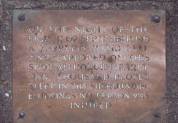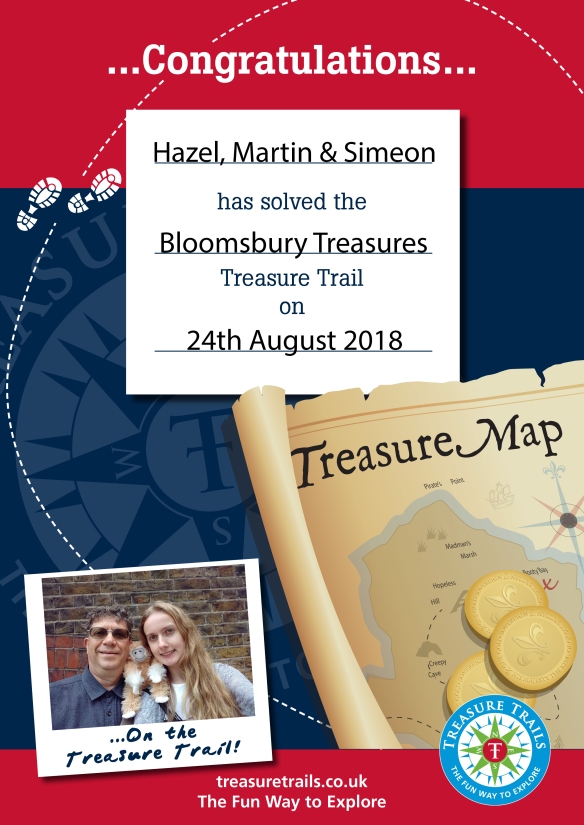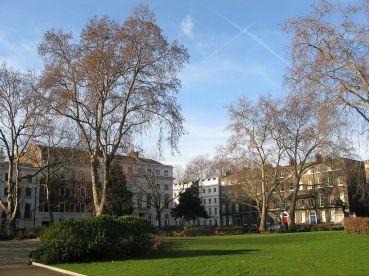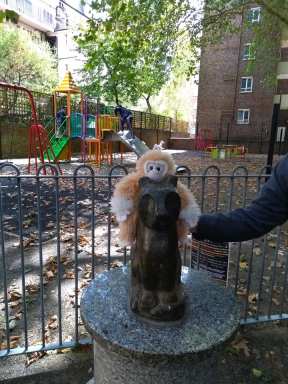Simeon gears up for the trail with a cup of tea at Leon
Earlier this year, Simeon the red-haired gibbon (toffee-coloured, if you please) went on an adventure to Amsterdam. Ever since Simeon has had a strong urge to travel but never the opportunity. So, it was with great excitement and enthusiasm when Simeon was invited to take part in a Treasure Trail around the area of Bloomsbury in Greater London. The intrepid explorer spent the day traipsing around gardens and squares as well as admiring the statues and blue plaques of people associated with the area. Napping on the way home thoroughly exhausted, Simeon smiled in his sleep, looking forward to telling everyone he meets about the things he learnt in Bloomsbury.
Bloomsbury is an area within the London Borough of Camden and stretches from Euston Road to Holborn. Associated with art, education and medicine, Bloomsbury is home to many hospitals, including Great Ormond Street, as well as museums and educational establishments, such as the British Museum and the Senate House Library. It is also a fashionable residential area with many parks, squares and quiet places, which makes a change from the rest of the bustling city.
As Simeon discovered, many notable people have lived in Bloomsbury over the past few centuries, however, its origin dates back as far as the 13th century. In 1210, William de Blemond, a Norman landowner purchased the land, building himself a manor house on the property. The name Bloomsbury is derived from Blemondisberi, which means “manor of Blemond”.
For a long time, Bloomsbury remained a rural area, which was acquired by Edward III (1312-77) in the late 14th-century and passed on to the London Charterhouse Carthusian Monks. However, after the dissolution of the monasteries in the 16th-century, Henry VIII (1491-1547) granted it to Thomas Wriothesley, 1st Earl of Southampton (1505-50). The land was passed down the Wriothesley line until it reached the 4th Earl of Southampton (1607-67), who is responsible for the development of Bloomsbury Square. The majority of the urban district, however, was laid out by the property developer James Burton (1761-1837), who also lived in the area. He has been recorded as possibly the most significant builder of Georgian London and it is with thanks to him that Bloomsbury has become the place it is today.
Bloomsbury is particularly known for its magnificent green squares of which there are at least ten. Simeon, being only a little gibbon, did not have the time nor energy to explore them all, however, the ones he did visit left a favourable impression in his stuffed head.

Russell Square Gardens
To begin the trail, Simeon started at Russell Square Underground Station where, a short walk to the left, lies Russell Square Gardens. This is one of the largest gardens in Bloomsbury and is named after the surname of the Dukes of Bedford who helped to develop the area. Initially laid out in 1804, the gardens are surrounded by large terraced houses, which were originally aimed at upper-middle-class families. Today, the gardens contain a fountain, which was installed in 2002 during a re-landscaping project to make the square look more like the original plans drawn out by the 18th-century landscaper, Humphry Repton (1752–1818).
Of course, Simeon could not go to Bloomsbury and not visit Bloomsbury Square, one of the earliest squares developed in London. Built in the 1660s and originally named Southampton Square after the 4th Earl of Southampton, the square now contains a small playground for young children, which includes a multicoloured roundabout that Simeon just had to try out.
Since 2011, Bloomsbury Square has become a physic garden with the help of 30 children from the Eleanor Palmer Primary School. In honour of Sir Hans Sloane (1660–1753), an Irish physician and naturalist, who lived in the area for half a century, the pupils planted a number of plants and flowers with medicinal properties that doctors used during the 17th-century. These include lavender, rosemary, milk thistle and sage.
Other well-known people also lived in the vicinity of Bloomsbury Square, including Isaac D’Israeli (1766-1848), a writer and scholar most famous for being the father of the British Prime Minister Benjamin Disraeli (1804-81). Another author who lived nearby, although only for a year (1902) was the American Gertrude Stein (1874-1946) whose best-known work is most probably The Autobiography of Alice B. Toklas (1933).
A smaller garden, surrounded by the National Hospital for Neurology and Neurosurgery, the Royal London Hospital for Integrated Medicine and Great Ormond Street Hospital, is titled Queen’s Square on account of the large statue of a queen standing at one end of the gardens. Mistakenly believed to be Queen Anne (1665-1714), the area was known as Queen Anne’s Square until the statue was identified as Queen Charlotte (1744-1818), the wife of George III (1738-1820). The king of Great Britain and Ireland was treated for mental illness in one of the buildings around Queen’s Square towards the end of his reign.
Like most squares built in the 18th-century, Queen’s Square was originally a fashionable area, popular with people such as Frances Reynolds (1729-1807), the sister of Sir Joshua Reynolds (1723-92) of the Royal Academy of Art, however, a hundred years later, the place was mostly inhabited by refugees, diverse booksellers and charity organisations. With occupiers unable to afford the running costs of the mansions, the buildings were gradually converted into hospitals.
 On the lawn towards the centre of the square is a concrete circle indicating where a Zeppelin bomb landed during the First World War. A plaque states that on the night of 8th September 1915, a bomb exploded on that very spot, whilst residents slept, unaware of the danger. Fortunately, no one was injured.
On the lawn towards the centre of the square is a concrete circle indicating where a Zeppelin bomb landed during the First World War. A plaque states that on the night of 8th September 1915, a bomb exploded on that very spot, whilst residents slept, unaware of the danger. Fortunately, no one was injured.
The British Museum is not the only notable museum in Bloomsbury; on the north side of Brunswick Square is the Foundling Museum, which tells the story of the Foundling Hospital set up by Thomas Coram (1668-1751) in 1741. The museum was established in 1998 and contains over 100 paintings, including those by William Hogarth (1697-1764), Thomas Gainsborough (1727-88), Joshua Reynolds and Louis-Francois Roubiliac (1702-62). These artists, as well as many others, donated their work to the Hospital as a way of raising funds for the home for parentless children. Members of the public were allowed to view the artworks for a small fee, thus effectively becoming Britain’s first art gallery.
A grand statue of Thomas Coram sits outside the entrance to the museum, between the building and Brunswick Square, which was once land belonging to the hospital. The Square is a public garden approximately 3 acres in size and is popular with the wildlife, particularly birds. The three plane trees – one is predicted to be over 200 years old – contain bird boxes to encourage the feathered-friends to nest. Frequently seen are magpies, great tits, wrens, jays and a whole host of other birds.
Brunswick Square is named after, Caroline of Brunswick (1768-1821), the wife of George IV (1762-1830). She was the queen consort at the time the square was completed by James Burton in 1802, although she most likely did not have any personal association with the area.
Jane Austen (1775-1817) used Brunswick Square as the setting of Mr and Mrs John Knightley’s residence in her novel Emma (1815). This, of course, was a work of fiction, however, a number of famous faces have lived around the square since its conception. John Ruskin (1819-1900) the Victorian critic, for example, was born at 54 Hunter Street, Brunswick Square and E.M. Forster (1879-1970), famous for short stories such as A Room with a View (1908) and A Passage to India (1924) lived at number 26 during the 1930s.
On the north side, a few houses down from the Foundling Museum lived three members of the Bloomsbury Group: Virginia Woolf (1882-1941), Leonard Woolf (1880-1969) and Duncan Grant (1885-1978) during 1911-12. The Bloomsbury Group, named after the area the majority of members lived, was a group of English writers, artists and intellectuals who regularly met up during the early 20th-century. “The Bloomsberries promoted one another’s work and careers …”
Other artists and writers who lived around the square include John Leech (1817-64), the illustrator of several Charles Dickens novels, and J.M. Barrie (1860-1937), the author famous for creating Peter Pan. Charles Dickens (1812-70) lived nearby at 48 Doughty Street in a Georgian terraced house with his family from 1837 until 1839. although he only stayed here for a brief period of time, number 48 is open to the public in the form of the Charles Dickens Museum.
Further down the road from Brunswick Square is a large open space for children, which covers 7 acres of land that once belonged to the Foundling Hospital. This was the original site of the Hospital until the 1920s when it was relocated. The site was due to be developed to match the rest of the urban area, however, Harold Harmsworth, 1st

Simeon stuck in the railings at Coram’s Field. Serves him right for trespassing!
Viscount Rothermere (1868-1940) had a vision of the area being converted into a safe place for children to play and donated a generous amount of money to the project. Appropriately titled Coram’s Field after the founder of the Foundling Hospital who made many children’s lives better, the park is still very popular with youngsters today.
Inside the iron gates are a large children’s playground, sand pits, and a duck pond. There are also places for parents to sit, such as a cafe, whilst they are accompanying their children. No person over the age of 16 may enter the premises without a child, thus making it a safe place for children to be children. Simeon was disappointed that he could not enter for, although he is only young, he did not count as a child!
Simeon’s tour of Bloomsbury went from one square to the next, however, in-between each one, the wide-eyed gibbon noticed many statues and blue plaques on houses belonging to some very famous names. Already mentioned are the statues of Thomas Coram and Queen Charlotte, but there are a few others worthy of note. Situated near Charlotte in Queen’s Square is a bust of Lord Wolfson of Marylebone (1927-2010). This was erected shortly after his death to mark his success as a businessman and philanthropist. Leonard Wolfson, who was knighted in 1977, was the chairman of the Wolfson Foundation established by his father. The charity awards grants to support the fields of science and medicine, health, education and the arts and humanities. It is only appropriate, therefore, that he be remembered in the presence of a few of the establishments he helped.
Simeon was intrigued to discover a statue of a cat in the Alf Barrett Playground hidden away on Old Gloucester Street. The cat, named Humphry, sits facing a bench dedicated to his maker, Marcia Stolway (1958-92). Humphry was the name of the cat that frequented the Mary Ward Centre in Queen’s Square where Marcia studied sculpture. Originally, the statue of Humphry the ginger cat was placed in Queen’s Square but it felt more appropriate for him to be by the children’s playground around people more likely to appreciate him. Sadly, Marcia died in 1992 at the age of 34 after suffering for a while from epilepsy. Humphry died the very same year, therefore, the statue and bench honour two remarkable characters from the area.
It is difficult to note all of the famous people who have ever lived in Bloomsbury because there have been and continue to be so many. English Heritage blue plaques appear on almost every street, revealing who lived there. Charles Dickens had a plaque outside his house, now a museum, and further down the road, a plaque exposed the former residence of Charlotte Mew (1869-1928), a Victorian poet. Also in Doughty Street, Vera Brittain (1883-1970) an English Voluntary Aid Detachment nurse and Winifred Holtby (1898-1935), a feminist writer both lived at 52. Around the corner, another plaque marks the house in which Hilda Doolittle (1886-1961), an American poet, once stayed.
Other notable names from the area include Vanessa Bell (1879-1961), Virginia Woolf’s sister; Randolph Caldecott (1846-88), illustrator; Charles Darwin (1809-82); Dorothy L. Sayers (1893-1957), novelist; and William Butler Yeats (1865-1939), poet. Some people only stayed for a fleeting visit to Bloomsbury, such as Bob Marley (1945-81), who stayed 6 months, and Vladimir Ilych Lenin (1870-1924), who lived there in 1908. Of course, there have been celebrities in more recent years, including Ricky Gervais (b1961) and Catherine Tate (b1968).
 If Simeon were to have a favourite of all the blue plaques, it would be the one revealing the residence of “The White Rabbit”. Whether or not Simeon realises this is not a real rabbit still remains unconfirmed but the codename belonged to the secret agent Wing Commander Forest Frederick Edward Yeo-Thomas (1902-64) who was a British Special Operations Executive agent in the Second World War. After his successful war work, Yeo-Thomas was invited to be one of the important witnesses at the Nuremberg War Trials and Buchenwald Trial. Following a successful career and being awarded the George Cross amongst several other medals, Yeo-Thomas, unfortunately, succumbed to a brain haemorrhage at the age of 62. It was not until 2010 that his London flat was recognised by an English Heritage blue plaque but, from now on, everyone who passes will know of “The White Rabbit” and his importance in the war.
If Simeon were to have a favourite of all the blue plaques, it would be the one revealing the residence of “The White Rabbit”. Whether or not Simeon realises this is not a real rabbit still remains unconfirmed but the codename belonged to the secret agent Wing Commander Forest Frederick Edward Yeo-Thomas (1902-64) who was a British Special Operations Executive agent in the Second World War. After his successful war work, Yeo-Thomas was invited to be one of the important witnesses at the Nuremberg War Trials and Buchenwald Trial. Following a successful career and being awarded the George Cross amongst several other medals, Yeo-Thomas, unfortunately, succumbed to a brain haemorrhage at the age of 62. It was not until 2010 that his London flat was recognised by an English Heritage blue plaque but, from now on, everyone who passes will know of “The White Rabbit” and his importance in the war.
Simeon came to the end of his trail satisfied that he had discovered the Bloomsbury Treasures. It is amazing to discover how much history can be contained in one area. The trail was created by Treasure Trails who provide a series of clues and directions that take you around Bloomsbury and make people look more closely at their surroundings. Providing a fun and educational day out, Treasure Trails have over 1000 trails for places all over Britain. Like Simeon, prepare to be amazed by interesting knowledge and details that usually get overlooked. Treasure Trails can be purchased online from their website for £6.99 and are suitable for children and adults.
“Where will my next adventure take me?” Simeon wonders. Hopefully, he will find out in the not so distant future.













Shear class. What a Gibbon, Simeon you deserve many more trails and treats. How interesting, who wood have thought so much history, so many famous people living in close proximity.
A very entertaining and brilliantly written piece. Hazel thank you for sharing and I look forward to more Simeon adventures.
Pingback: The Life and Designs of William Morris | Hazel Stainer
Pingback: Simeon Visits Rainham Hall | Hazel Stainer
Pingback: Simeon, the Cliffs and the Sea | Hazel Stainer
Pingback: A Lone Woolf | Hazel Stainer
Pingback: Simeon Investigates Covent Garden | Hazel Stainer
Pingback: Simeon and the Green Witch’s Treasure | Hazel Stainer
Pingback: GOSH: The Children First and Always | Hazel Stainer
Pingback: Simeon Encounters Antwerp | Hazel Stainer
Pingback: Lady Jane Franklin | Hazel Stainer
Pingback: Simeon Conquers York | Hazel Stainer
Pingback: Simeon’s Bristol Highlights | Hazel Stainer
Pingback: Katherine Mansfield | Hazel Stainer
Pingback: Simeon Returns to Bristol: Part One | Hazel Stainer
Pingback: Simeon Returns to Bristol: Part Two | Hazel Stainer
Pingback: Simeon goes to Grantham | Hazel Stainer
Pingback: Simeon and the Cable Car Mission | Hazel Stainer
Pingback: Simeon and the Quest for the Roman Hoard | Hazel Stainer
Pingback: Simeon and a Tale of Two Bridges | Hazel Stainer
Pingback: Simeon and the Cardiff City Mystery | Hazel Stainer
Pingback: Hello, Simeon Here | Hazel Stainer
Pingback: Simeon and the Buried Secret | Hazel Stainer
Pingback: Simeon and the Marylebone Murder | Hazel Stainer
Pingback: Simeon and the Roman Baths Mystery | Hazel Stainer
Pingback: Simeon Saves Westminster | Hazel Stainer
Pingback: Simeon and the Bath Cake-tastrophe | Hazel Stainer